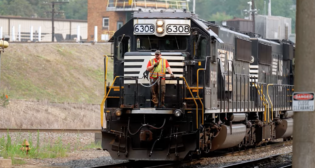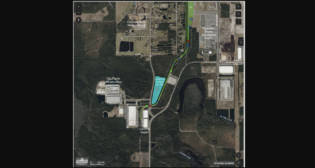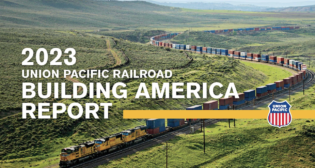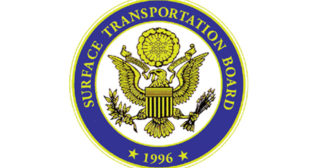
Shippers’ Lot Is Not a Happy One
Written by Frank N. Wilner, Capitol Hill Contributing EditorBy age 10, two lessons should be learned—no ketchup on hot dogs, and government does not move at the speed of for-profit business.
It follows from Lesson Two that a captive rail shipper’s lot is not a happy one—captive shippers being those lacking effective transportation alternatives to rail.
Since 1980, when railroads were partially deregulated under the Staggers Rail Act, and Congress promised captive shippers regulatory protection should railroads abuse market power, the response by regulators—the Surface Transportation Board and its Interstate Commerce Commission predecessor—has been sloth-like.
Déjà vu. For decades before the heavy yoke of railroad economic regulation was lifted, railroads suffered a similar fate as regulators wiggled, waggled, waffled and wavered while trucks so eroded rail market share that what was left of rail industry profits could fit neatly into a locomotive engineer’s lunch pail.
Alas, visiting upon shippers the sins previously committed against railroads is not equitable public policy. In fact, Congress provided in the 1980 Staggers Rail Act that regulators must henceforth balance the objectives of assisting railroads in attaining revenue adequacy against ensuring that the rates individual shippers pay are reasonable.
Yet it developed that the cost to shippers in seeking regulatory remedies for alleged “unreasonable” rail rates often exceeded the value of the case.
That expensive regulatory process, known as the Stand-Alone Cost (SAC) test, requires, in part, that a complaining shipper design, on paper, a hypothetical least-cost, most-efficient replacement railroad. Conservatively, pursuing a SAC case can cost a shipper $5 million.
As many shipper rate challenges are dismissed or fail to recover the cost of bringing the case, shippers have been reluctant to seek the protections promised them by Congress.
That contravenes another congressional directive issued in 1995—that regulators “establish a simplified and expedited methodology for determining the reasonableness of challenged rail rates in those cases in which a full SAC presentation is too costly, given the value of the case.”
Although the STB on Sept. 12 proposed several new rules to accomplish that congressional directive—rules similar to STB attempts in 2007 and 2013 that failed to accomplish the intended result—there remains “a long way to Tipperary,” and likely a longer way to go.
With the stakeholder comment period for the Sept. 12 STB proposals extending into January 2020, months more could pass before the STB publishes final rules. And they could be quite different than the Sept. 12 proposals. Moreover, judicial appeals by shippers or railroads are likely, with the possibility of a court remand and then further appellate delays.
Then there is a roll-of-the dice risk for shippers. After the Western Coal Traffic League earlier this year asked a federal court to order the STB to stop its Beetle Bailey impersonation and rule on a five-year pending rulemaking affecting locomotive fuel surcharges—Ex Parte No. 661 (Sub-No. 2)—the Board awoke only to terminate the proceeding Aug. 29, thus retaining a status quo upsetting to shippers.
With currently two vacant seats on the five-member STB, and no assurance that even the current three members will continue—following stakeholder comments—to support the Sept. 12 proposals, captive shippers could find themselves in the same kettle of fish in which they have been stewing since the complex and costly SAC test was created in 1985.
This is not intended as a sob-sister column on the plight of captive shippers. Indeed, the notion that chemicals-manufacturing giants such as DuPont, with 98,000 employees, market capitalization of some $55 billion and annual revenue of some $85 billion require economic protection from railroads strains the oft-used phrase, “common sense.” But Congress spoke, and when Congress speaks, regulatory agencies that administer congressionally passed statutes must do more than listen.
What even more defies common sense is how and why devising less complex and less costly methodologies to identify unreasonable rates and prescribe reasonable ones has taken almost four decades, and counting.
In fact, the proposed new rules speak only to a small percentage of captive shippers, because if they cannot satisfy six newly created specific criteria demonstrating railroad market power, the status quo is retained, regardless if the proposed rules became finalized and unchanged today.
Indeed, shippers, still smarting following the STB’s Aug. 29 decision to terminate a promised rulemaking on locomotive fuel surcharges, now are skeptical as to the fate of the Sept. 12 proposals affecting so-called small rate cases.
Here are links to the three Sept. 12 STB proposals:
Ex Parte No. 755, Final Offer Rate Review; and Ex Parte No. 665 (Sub-No. 2), Expanding Access to Rate Relief: https://www.stb.gov/decisions/readingroom.nsf/9855c1fb354da09b85257f1f000b5f79/1d5c55a4466e4e4785258473004dc82d?OpenDocument
Ex Parte No. 756, Market Dominance Streamlined Approach: https://www.stb.gov/decisions/readingroom.nsf/9855c1fb354da09b85257f1f000b5f79/1e813d412a40f03085258473004e1f0b?OpenDocument
An Events Timeline
For those curious as to the genesis of these latest STB proposals, following is an abbreviated history:
Following the Interstate Commerce Commission’s 1985 adoption of Coal Rate Guidelines—Ex Parte No. 347 (Sub-No. 1)—that established the Stand-Alone Cost (SAC) methodology for deciding captive-shipper rate reasonableness complaints, regulators concluded SAC was too complex, too costly and inappropriate for all but high-volume, repetitive movements such as unit coal trains.
First Simplification Attempt
In an initial attempt to reduce captive-shipper litigation costs often topping $5 million, the ICC developed “simplified guidelines” in 1987—Ex Parte No. 347 (Sub-No. 2)—for relatively low-volume shipments with diverse origins, terming them medium- and small-size shipments. A Revenue-to-Variable Cost (R/VC) test made comparisons with selected “benchmark” traffic having similar transportation and demand characteristics. A Formula Replacement Cost (FRC) test used an ICC generalized-purpose costing system to simulate stand-alone costs.
The FRC test was rejected by the ICC in 1988 as “incompatible with demand-based differential pricing principles. The R/VC test met its end after an appellate court in 1993ruled the ICC had failed to justify why it was superior to the maligned SAC test.
In 1995, Congress—in a rare instance of satisfying captive shipper legislative objectives—directed regulators to “establish a simplified and expedited methodology for determining the reasonableness of challenged rail rates in those cases in which a full stand-alone cost presentation is too costly given the value of the case.” It was part of the Interstate Commerce Commission Termination Act creating the STB to succeed the ICC.
Second Simplification Attempt
In December 1996, the STB published Rate Guidelines – Non-Coal Proceedings—Ex Parte No. 347 (Sub-No. 2)—describedas simplified evidentiary guidelines for captive shippers not practicably able to use the SAC test.
As with the SAC test, a captive shipper, by statute, must demonstrate a railroad possesses market dominance—“an absence of effective competition from other carriers or modes of transportation for the traffic or movement to which a rate applies”—before the STB will consider a rate challenge. Known as Three-Benchmark, it contained a methodology to determine the reasonableness of a challenged rate using three benchmarks, each expressed as a ratio of revenue to variable costs (revenue earned on a specific movement divided by the variable cost of providing the service). The STB ruled, however, that the more complex and costly SAC test still must be utilized wherever possible, and shippers seeking to utilize Three-Benchmark must demonstrate that the SAC test is not practical.
The first benchmark—the Revenue Shortfall Allocation Method (RSAM) method—measures the average markup above variable costs the railroad needs to charge its “potentially captive” traffic in order for the railroad to earn adequate revenue.
The second benchmark—the Revenue-to-Variable Costs Greater Than 180% test (R/VC>180)—measures the average markup above variable costs actually being earned by the defendant railroad on its high-rated (captive) traffic.
The third benchmark—the Revenue-to-Variable Costs Comparison (R/VCCOMP)—measures the degree of differential pricing actually being practiced by the defendant railroad by comparing the markup being paid by the challenged traffic to the average markup assessed on other potentially captive traffic involving the same or a similar commodity moving similar distances.
Based on results of the three benchmarks, the STB determined rate reasonableness, with a new “lawful” rate prescribed where rates were found to be unreasonable.
Still, No Takers
Almost seven years following adoption by the STB of Three-Benchmark, with not a single shipper choosing to use it, the STB initiated a series of public hearings in 2003 “to examine why those guidelines have not been used by shippers and to explore ways to improve them.” A multitude of shipper organizations jointly told the STB that the guidelines do not provide a clear standard that complainants know they must satisfy in order to obtain relief.
In October 2003, then STB Chairman Roger Nober told a Senate Surface Transportation Subcommittee that “if no small cases are brought, this means that in practice, only about 75 coal shippers have a meaningful opportunity to challenge rail rates. This is unacceptable.”
As his Senate confirmation hearing in 2006, incoming STB Chairman Charles Nottingham was challenged by Sen. Conrad Burns (R-Mont.): “Previous nominees, Mr. Nottingham, have sat right in that chair where you’re sitting right now and promised they’d get the small rate case into effect … and it’s yet to happen.” Nottingham acknowledged that the existing rules had “a chilling effect” on small rate cases being filed.
Third Simplification Attempt
In 2007, a chastised STB, with Nottingham as chairman, revised Three-Benchmark—Ex Parte No. 646 (Sub-No. 1)—to create a second simplified methodology known as Simplified-SAC, and established recovery thresholds for rate challenges:
Large-value disputes—with a maximum case value over five years in excess of $3.5 million—would be required to use the full-SAC test. Maximum value means rate relief the shipper might attain over five years if the challenged rates were reduced to the jurisdictional floor of 180% of the railroad’s variable costs. The STB presumed that with a potential recovery greater than $3.5 million, the complainant could afford to present a full-SAC presentation.
Medium-size value disputes—with a maximum case value over five years of between $200,000 and $3.5 million—were made eligible for Simplified-SAC, which is conceptually the same as the full-SAC test procedure, but less complex and less costly to pursue. The complainant is not required to design a hypothetical stand-alone railroad. Instead, the complainant estimates the stand-alone cost of providing the current service, with its current traffic, on the actual railroad. The complainant uses the Uniform Rail Costing System (URCS) to estimate operating costs, and also estimates the return on investment required to replicate the infrastructure.
The maximum allowable recovery under the Simplified-SAC was set at $5 million over five years, a sum tied to the estimated rate relief obtainable, as well as legal costs, of pursuing the rate challenge.
Small value disputes—with a maximum case value over five years lower than $200,000—were eligible for Three-Benchmark, the least costly means of challenging a rate where the value of the case cannot justify the expense of the full-SAC or Simplified-SAC presentation. The maximum allowable recovery when using Three-Benchmark was $1 million over five years.
In 2013, the STB raised the dollar amount of recovery available under Three-Benchmark from its then-indexed $1.2 million to $4 million, and eliminated entirely the $5 million relief cap under Simplified-SAC (Ex Parte No. 715). The STB said the lower relief caps were discouraging shippers from filing cases.
More Shipper Ennui
Shippers continued to boycott the process. When reauthorizing the STB in 2015, Congress renewed its 1995 instructions—slightly reworded—that the STB “shall maintain one or more simplified and expedited methods for determining the reasonableness of challenged rates in those cases in which a full [SAC] presentation is too costly, given the value of the case.”
Fourth Simplification Attempt
Four years later—this past Sept. 12, and drawing on recommendations of an internal task force—the STB issued three new proposals intended, once again, to make it less complex and less expensive for captive shippers to file rate complaints where expected recovery is too small to justify a full-blown SAC test.
Proposed in two coordinated dockets—Ex Parte No. 755, Final Offer Rate Review; and Ex Parte No. 665 (Sub-No. 2), Expanding Access to Rate Relief—is creation of an alternative to Simplified-SAC and Three-Benchmark. The alternative—the latest attempt at simplifying and making less costly the shipper process of filing a rate complaint—is termed “Final Offer Rate Review” (FORR).
To decide a case under FORR, the STB would select either the complainant’s or the defendant’s final offer, with a decision to be made by the Board within 135 days after the complaint is filed.
The final offers would include what each party considers to be the maximum reasonable rate, and the complainant has the burden to prove that the defendant railroad has market dominance over the transportation to which the rate applies, and then that the challenged rate is unreasonable. Both the market dominance and rate reasonableness evidence would be introduced together.
FORR would retain the $4 million rate relief cap over two years established in 2013 for Three-Benchmark, effectively discouraging larger-value cases from using FORR.
Streamlined Market Dominance
Significantly, complainants would be eligible to use FORR only if they utilize a streamlined methodology for determining market dominance as contained in the third Sept. 12 STB proposal—Ex Parte No. 756, Market Dominance Streamlined Approach.
Under this approach, the complainant must satisfy six criteria:
- The challenged rate is at least 180% of the movement’s variable costs.
- The movement between origin and destination exceeds 500 highway miles (a long-standing assumption of distance when truck loses its competitive advantage over rail).
- There is no intramodal (rail) competition.
- There is no barge competition.
- Over the previous five years, the complaining shipper has used trucks for 10% or fewer of its movements.
- The complaining shipper has no build-out alternative (the ability to construct track to reach a competing railroad) owing to physical, regulatory, financial or “other” issues.
This streamlined approach could also be used under full-SAC or Simplified-SAC procedures, but for these cases, if all six factors cannot be established, market dominance must be demonstrated thorough the non-streamlined methodology.
The Association of American Railroads said of the proposed Sept. 12 rules that it is reviewing them and would be “fully engaged” in the regulatory process going forward.
Frank N. Wilner is author of six books, including Amtrak: Past, Present, Future; Understanding the Railway Labor Act; and Railroad Mergers: History, Analysis, Insight, all published by Simmons-Boardman Books. Wilner earned undergraduate and graduate degrees in economics and labor relations from Virginia Tech. He has been assistant vice president, policy, for the Association of American Railroads; a White House appointed chief of staff at the Surface Transportation Board; and director of public relations for the United Transportation Union. He is a past president of the Association of Transportation Law Professionals. Wilner drafted the railroad section of the Heritage Foundation’s Mandate for Leadership (Volumes I and II), which were policy blueprints for the two Reagan Administrations; and was a guest columnist for the Cato Institute’s Regulation magazine.



